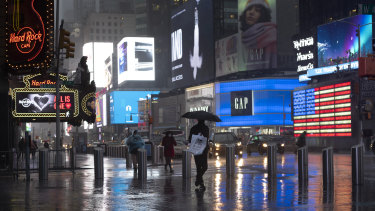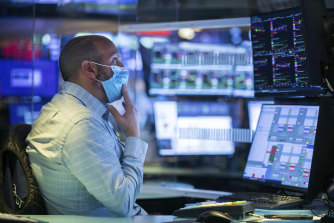For our free coronavirus pandemic coverage, learn more here.
The US economy remains mired in a pandemic winter of shuttered storefronts, high unemployment and sluggish job growth. But on Wall Street and in Washington, attention is shifting to an intriguing if indistinct prospect: a post-COVID boom.
Forecasters have always expected the pandemic to be followed by a period of strong growth as businesses reopen and Americans resume their normal activities. But in recent weeks, economists have begun to talk of something stronger: a supercharged rebound that brings down unemployment, drives up wages and may foster years of stronger growth.
Better times may be just around the corner for the battered US economy.Credit:AP
There are hints that the economy has turned a corner: Retail sales jumped last month as the latest round of government aid began showing up in consumers’ bank accounts. New unemployment claims have declined from early January, though they remain high. Measures of business investment have picked up, a sign of confidence from corporate leaders.
Economists surveyed by the Federal Reserve Bank of Philadelphia this month predicted that US output will increase 4.5 per cent this year, which would make it the best year since 1999. Some expect an even stronger bounce: Economists at Goldman Sachs forecast that the economy will grow 6.8 per cent this year and that the unemployment rate will drop to 4.1 per cent by December, a level that took eight years to achieve after the last recession.
“We’re extremely likely to get a very high growth rate,” said Jan Hatzius, Goldman’s chief economist. “Whether it’s a boom or not, I do think it’s a V-shaped recovery,” he added, referring to a steep drop followed by a sharp rebound.
The growing optimism stems from the confluence of several factors. Coronavirus cases are falling in the United States. The vaccine rollout, though slower than hoped, is gaining steam. And largely because of trillions of dollars in federal help, the economy appears to have made it through last year with less structural damage — in the form of business failures, home foreclosures and personal bankruptcies — than many people feared last spring.
“There will be this big boom as pent-up demand comes through and the economy is opening. There is an awful lot of buying power that we’ve transferred to households to fuel that pent-up demand.”
Lastly, consumers are sitting on a trillion-dollar mountain of cash, a result of months of lockdown-induced saving and successive rounds of stimulus payments. That mountain could grow if Congress approves the aid to households that President Joe Biden has proposed.
When the pandemic ends, cash could be unleashed like melting snow in the Rockies: Consumers, released from their cabin fever, compete for hotel rooms and restaurant tables. Businesses compete for employees and supplies to meet the demand. Workers who were sidelined by child care responsibilities or virus fears are drawn back to the labor force by suddenly abundant opportunities.
“There will be this big boom as pent-up demand comes through and the economy is opening,” said Ellen Zentner, chief US economist for Morgan Stanley. “There is an awful lot of buying power that we’ve transferred to households to fuel that pent-up demand.”
That vision is far from a certainty. Delays in the vaccine rollout could stall the recovery. So could new strains of the virus that render vaccines less effective. A political standoff in Washington could hold up aid for unemployed workers and struggling businesses. And even if the economy avoids all of those traps, there is unlikely to be a single moment when public health officials give an “all clear”; it could be years before people pack into bars and sports stadiums the way they did before the pandemic.
A boom also carries risks. In recent weeks, prominent economists including Lawrence H. Summers, a Treasury secretary under President Bill Clinton, have warned that Biden’s relief proposal is too large and could lead the economy to overheat, pushing up prices and forcing the Federal Reserve to bring the party to a premature end. Fed officials have largely dismissed those concerns, noting that the consistent problem in recent decades has been too little inflation rather than too much.
Other economists fear that the rebound will primarily benefit those at the top, compounding inequities that the pandemic has widened.
“We may see a boom in the future, but that may just leave some people even further behind, or may give them a trickle when they need a waterfall,” said Tara Sinclair, a George Washington University economist.
But for many businesses and households that have struggled to stay afloat during the pandemic, those concerns pale in comparison with the opportunities that a boom could provide.
US stocks have soared to record highs.Credit:AP
There is no single definition of a boom, nor a committee of elite economists who agree when one has begun, as there is with recessions. But economists generally agree that booms are characterised by a combination of strong growth and a high absolute level of activity. By that standard, the period after World War II certainly qualifies as a boom. So do the late 1960s.
In recent decades, however, booms have become less common. Growth never took off after the mild recession that hit in 2001, and while the unemployment rate hit a half-century low after the last recession, it took a decade to get there.
Even if there is a strong rebound, however, economists warn that not everyone will benefit.
Kara Gray and her husband, Christopher DeSure, spent years building their small Ohio construction company into a successful business. Then the pandemic shut them down, and, having a daughter at home with a compromised immune system, they haven’t felt comfortable returning to in-person work.
With the housing market strong, Gray is confident they will be able to get back to work once the pandemic is over. But she worries they won’t be able to take full advantage of the boom. She and her husband were forced to spend the money they had set aside to buy a house, and have fallen behind on bills and run up credit card debt. That could make it hard for them to qualify for a mortgage or for a business loan to expand their company.
“It’s going to affect me and my husband longer term,” she said. “It’s not just ‘Can I pay my bills this month?’ It’s that once this is over, I’m going to have to start all over.”
The New York Times
Business Briefing
Start the day with major stories, exclusive coverage and expert opinion from our leading business journalists delivered to your inbox. Sign up for the Herald‘s here and The Age‘s here.
Most Viewed in Business
Source: Read Full Article


